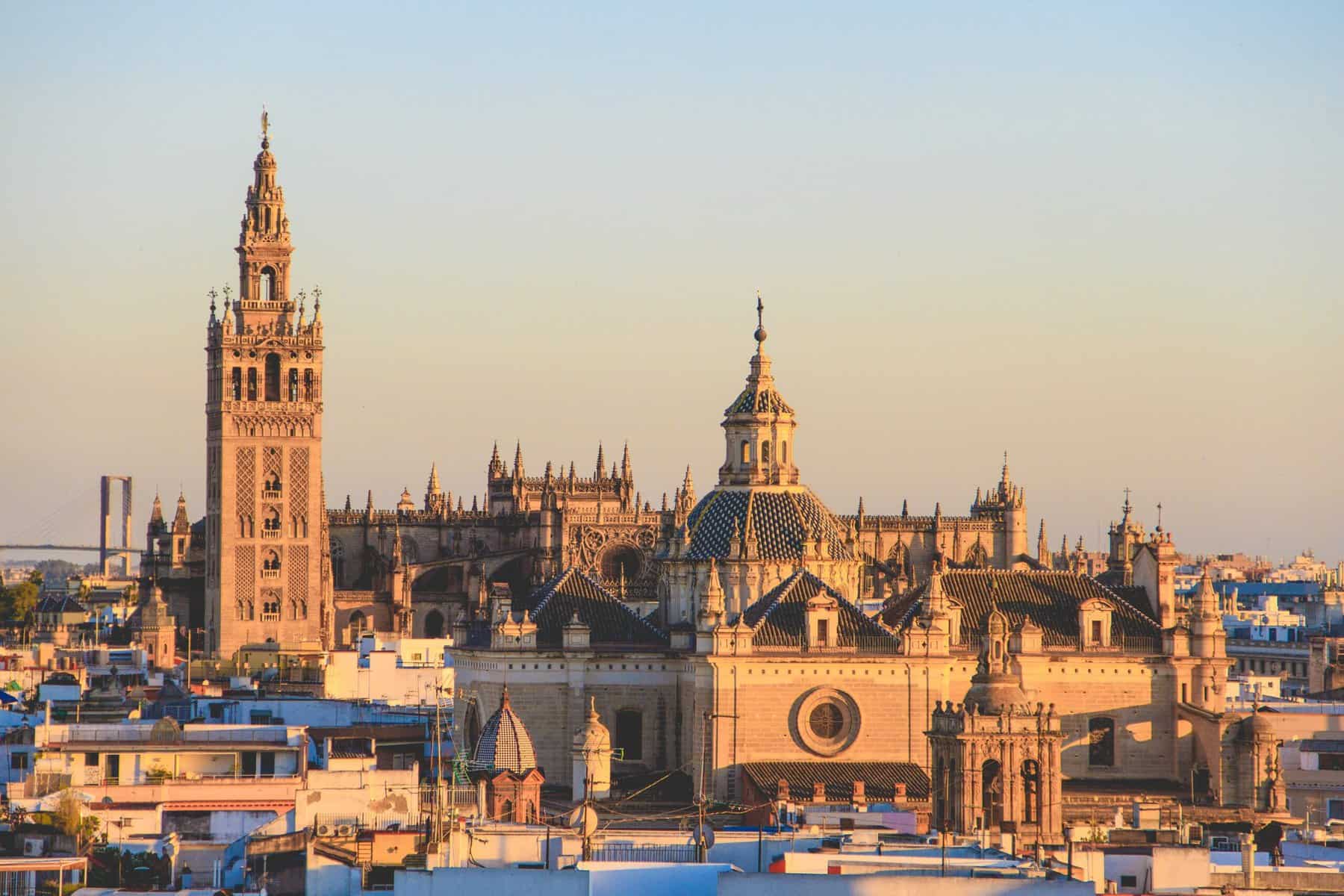
Experience Seville | Best Things To See & Do

Seville is a magical city bursting with history, culture, and beauty just waiting to be experienced, filled with so many things to see and do. As one of the oldest cities in Europe, its streets are lined with ornate architecture dating back centuries, its plazas buzz with flamenco shows and lively locals, and its winding alleyways have hidden treasures around every corner.
From its fairytale-like Alcázar Palace to its vibrant tapas scene and historic neighbourhoods. Seville offers an eclectic mix of experiences that will leave even the most well-travelled adventurer feeling like they’ve entered another world.
In this guide, I’ll breakdown the best things you must do and see on your visit to experience the very best this cultural gem of southern Spain has to offer. So let’s get started.
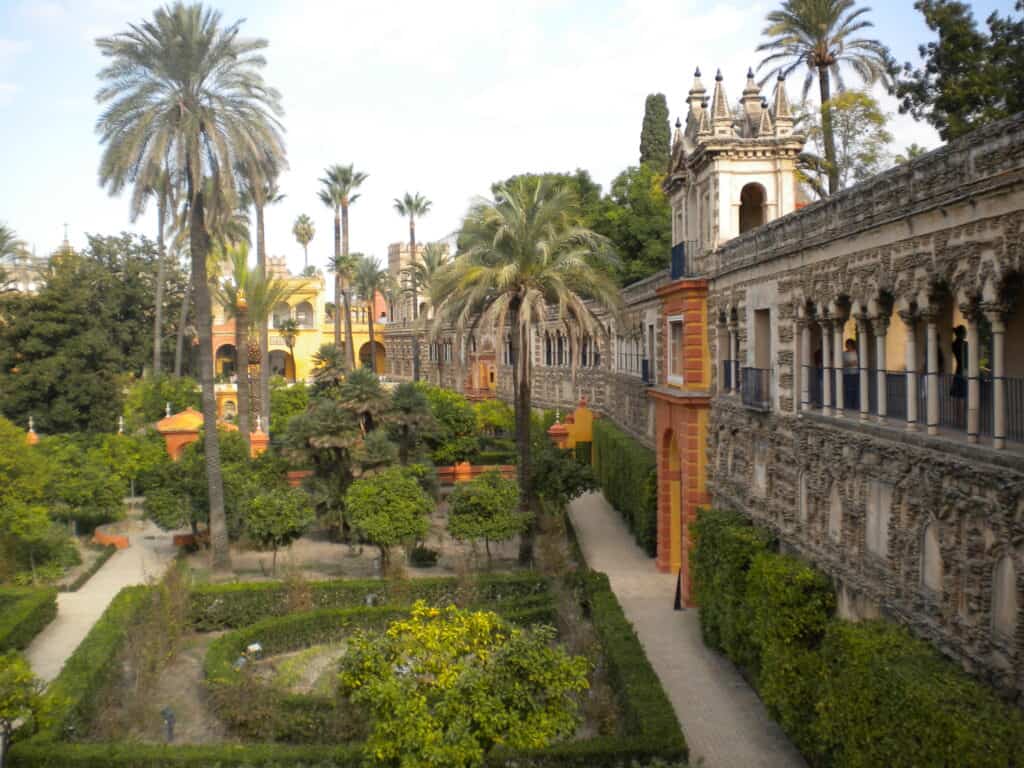
Explore Real Alcázar de Sevilla
Visiting the Real Alcázar de Sevilla is a great experience and one of the best things to do when in Seville. I cannot recommend this place enough; it is magnificent.
From its exquisite Mudejar architecture to its lush gardens, every corner of this royal palace speaks volumes about the lives of the monarchs who one resided there. Its perfect blend of Christian and Moorish aesthetics, coupled with its serene gardens, makes it one of the best things to do when visiting Seville.
What To See – The Real Alcázar is a complex of palaces, each built during different periods and exhibiting distinct architectural styles.

The Palacio del Rey Don Pedro, also known as the Palace of King Peter I, is perhaps the most famous part of the Alcázar. Built in the Mudejar style in the 14th century, it is a stunning example of the fusion of Islamic and Christian architecture. The palace is adorned with intricate plasterwork, colourful tiles, and beautiful arches, reflecting the aesthetic sensibilities of the period. King Peter I, who commissioned the palace, wanted to create a royal residence that rivaled the Alhambra in Granada. Today, this palace stands as a testament to his vision.
Adjacent to the Palacio del Rey Don Pedro is the Gothic Palace. This structure was built by the Christian kings Alfonso X and Fernando III after they conquered Seville. The Gothic Palace is markedly different from its Mudejar neighbour, with its high vaulted ceilings, grand stone pillars, and ornate stained glass windows. The Tapestry Room is a highlight of this palace, where you can marvel at a collection of tapestries depicting scenes from the conquest of Tunisia.
The Halls of Charles V are a later addition to the Alcázar, built during the reign of Emperor Charles V in the 16th century. These halls showcase the Renaissance style, with their finely carved wooden ceilings and impressive tapestries. One of the main attractions here is the Admiral’s Room, which served as the headquarters of the House of Trade with the Americas. This room houses a collection of navigational charts, maps, and historical documents.
The Gardens of the Real Alcázar are as enchanting as the palaces themselves. They cover a vast area and are divided into sections, each representing different periods and styles. The oldest garden is the Garden of the Poets, designed in the Moorish style with fountains, pavilions, and geometrically arranged flower beds. The Garden of the Prince, the largest section, is a more recent addition, showcasing English landscaping styles with its winding paths, romantic hideaways, and diverse plants. The gardens also house several pavilions, including the Pavilion of Carlos V, a perfect spot to rest and take in the beauty of the surroundings.
Getting There – The Real Alcázar is located in the heart of Seville, adjacent to the Seville Cathedral. It’s easily reachable by public transport and the nearest tram stop is Archivo de Indias, just a few minutes’ walk away. If you’re staying in the city centre, you can easily reach the Real Alcázar on foot.
Tickets & Opening Hours – It’s highly recommended to buy your tickets in advance, especially during the peak tourist season. This will help you avoid the long queues. You can purchase them online or from the ticket office at the entrance. There are reduced prices for students, pensioners, and disabled visitors.
The Real Alcázar is open every day of the week, with operating hours from 9:30 AM to 7:00 PM from April to September, and from 9:30 AM to 5:00 PM from October to March.
Practical Tips – The Real Alcázar is a popular attraction so here are a list of practical tips to help you plan your visit.
Try to arrive early to beat the crowds. Allocate at least two to three hours for your visit to fully appreciate its beauty and wear comfortable shoes.
Audio guides are available for rent at the entrance. They provide valuable insights into the Alcázar’s history and architecture.
Photography is allowed, but without flash (when inside buildings).
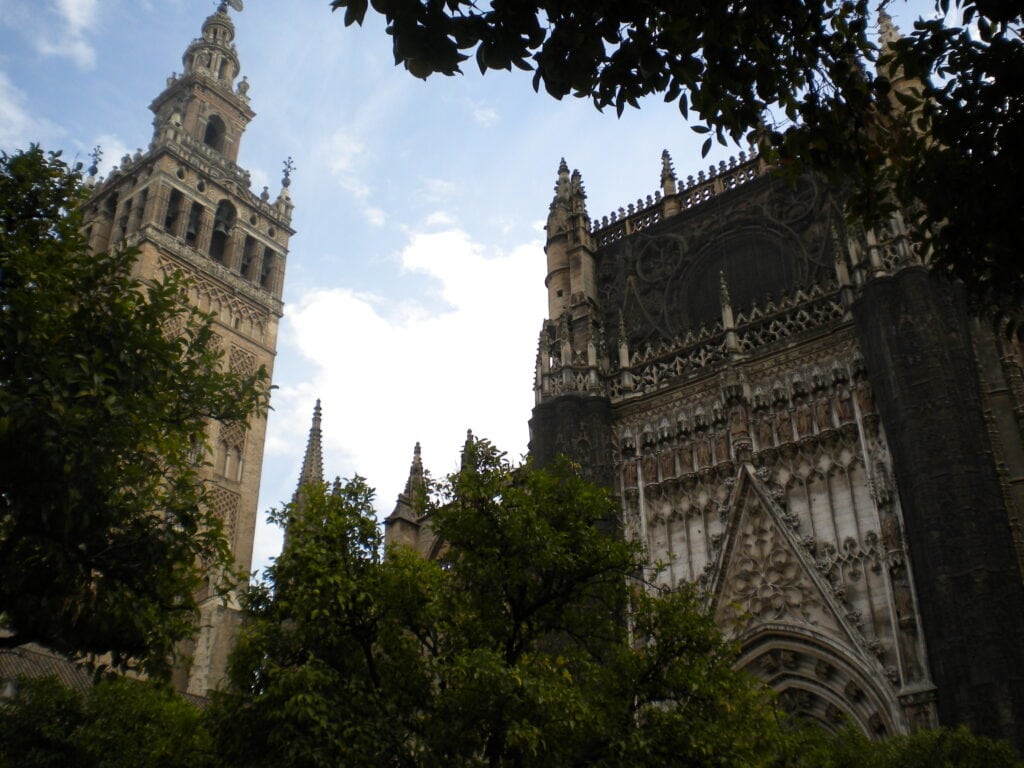
Visit The Cathedral & Geralda Tower
Visiting the Seville Cathedral is another top thing to do when visiting Seville. The cathedral is one of the world’s largest Gothic cathedrals and the third-largest church overall. The cathedral houses numerous works of art and historical artefacts, including the tomb of Christopher Columbus.
Its stunning architecture, featuring intricate carvings and soaring arches, is a feast for the eyes. Climbing the Giralda tower, originally a minaret of the mosque that stood on the site before the cathedral, offers breathtaking panoramic views of the city. The cathedral’s sheer size, historical significance, and architectural beauty make it a must-visit landmark and a great experience.
What To See – Upon entering the cathedral, you’re immediately struck by its sheer size and grandeur. The central nave, rising to a height of 42 metres, is flanked by two side aisles, creating an expansive space adorned with intricate woodcarvings and gold leaf detailing.
The main altarpiece is a true masterpiece of Gothic woodcarving. Created by Pierre Dancart, it showcases scenes from the life of Christ, with each panel telling a different biblical story. This stunning piece of craftsmanship is a must-see for any art enthusiast.
Another significant feature inside the cathedral is the tomb of Christopher Columbus. Held aloft by four statues representing the four kingdoms of Spain during Columbus’s life.
The cathedral also houses numerous chapels, each filled with a variety of religious paintings and sculptures. The Sacristía Mayor, or Main Sacristy, deserves a special mention. Here, you can admire works by renowned Spanish painters such as Murillo and Zurbarán.
The exterior of the cathedral is just as impressive as its interior. The Door of the Conception and the Door of the Prince, notable for their detailed carvings, are worth taking the time to appreciate. The cathedral’s garden and courtyard area, known as the Patio de los Naranjos, is a serene space filled with orange trees. It’s a perfect spot to relax and soak in the cathedral’s majestic presence.
The Giralda tower, originally a minaret for the mosque that once stood on the site, is now the cathedral’s bell tower. Standing at a height of 104.5 metres, it’s one of Seville’s most iconic landmarks. The tower is unique in that it’s ascended by ramps rather than stairs, a design feature that allowed the muezzin to ride a horse to the top for the call to prayer. Climbing the tower will reward you with breathtaking views of the city.
Getting There – The cathedral is centrally located and is easily accessible by public transport. The nearest tram stop is Archivo de Indias and just a few minutes walk to the cathedral. If you’re staying in the city centre, you can comfortably reach the cathedral on foot.
Tickets & Opening Hours – It is highly recommended to purchase your tickets in advance to avoid long queues, particularly during the peak tourist season. Tickets can be bought online or from the ticket office at the entrance.
The cathedral’s opening hours are typically from Mon-Sat 9:30 AM to 5:00 PM, and on Sundays from 2:30 PM to 7:30 PM. However, these timings may vary depending on religious ceremonies and other cultural activities, so it’s recommended to check the Cathedral’s website in advance.
Practical Tips – The Seville cathedral is a very popular attractions, so here are some practical tips:
Arrive early to beat the crowds and allow at least 2 hours to explore and enjoy the building.
Wear comfortable shoes, especially if you plan to climb the Giralda tower.
Audio guides are available for rent. They provide valuable insights into the cathedral’s history and architecture.
Photography is allowed inside, but without flash.
Free tickets are available on certain days (between 2-3pm), however they get booked very quickly. If you fancy your luck, checkout the cathedral website.
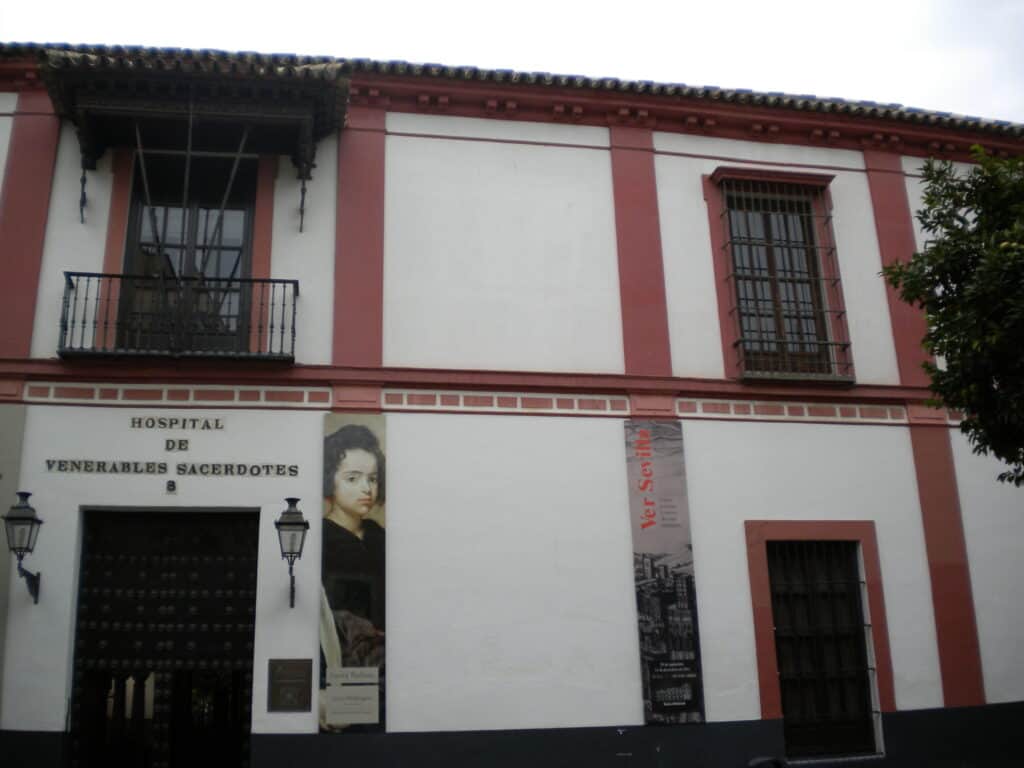
Explore The Santa Cruz District
Seville’s Santa Cruz district, also known as Barrio Santa Cruz, is a must-visit gem steeped in history and brimming with charm. Nestled in the heart of Seville, very close to the Alcázar palace, this former Jewish quarter captures the essence of Andalusian tradition and culture. As you wander through its labyrinthine streets and alleys, you’ll be surrounded by 12th-century buildings, cobbled stone paths, and whitewashed houses.
This neighbourhood also offers a great selection of artisan shops, cafes, and restaurants where you can indulge in local cuisine and crafts.
Also, in this district you can find a remarkable baroque structure that harks back to the 17th century – the Hospital de los Venerables. Originally serving as a residence for elderly, impoverished, and infirm priests.
The Hospital de los Venerables is a treasure trove of remarkable art. It houses the Velázquez Centre, dedicated to the famous Sevillian painter Diego Velázquez, and features around 12 works of art in its permanent collection.
In addition to the art, the building also has a stunning baroque church adorned with fresco paintings including Valdés Leal.
The Hospital de los Venerables is open from Mon-Sat between 10:00 AM to 7:00 PM, and on Sundays from 10:00 AM to 3:00 PM. Tickets can be purchased at the entrance or on the website.
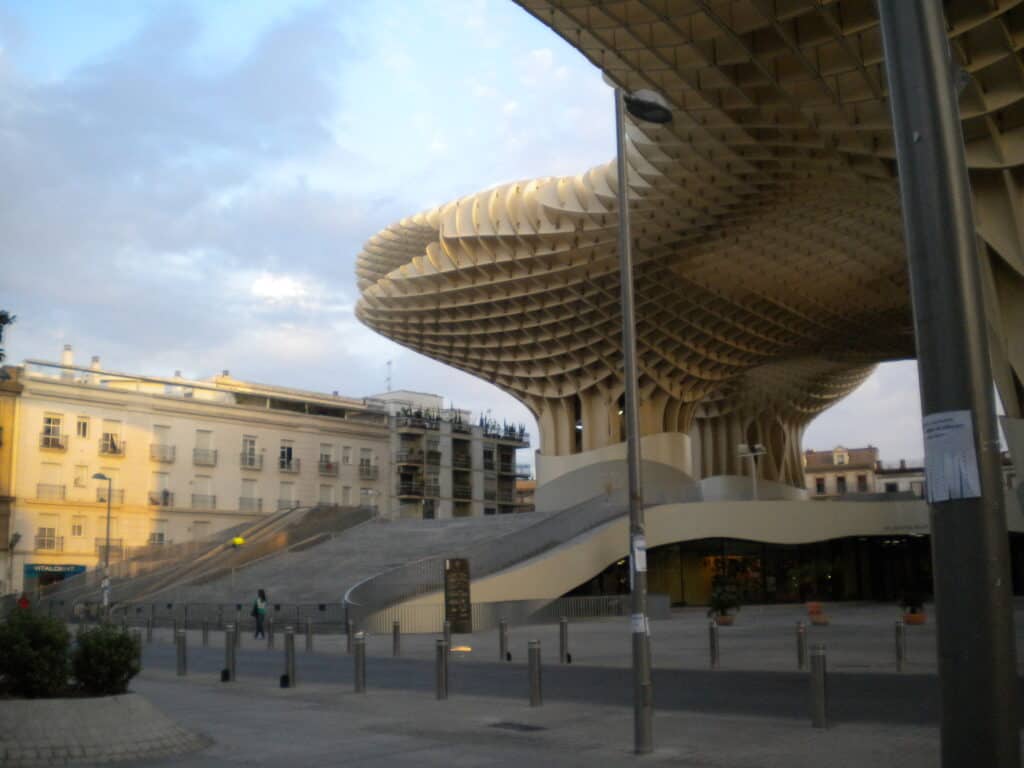
Visit The Metropol Parasol – The World’s Largest Wooden Structure
The Metropol affectionately known by locals as “Las Setas” or “The Mushrooms,” is a modern architectural marvel situation on the the Plaza de la Encarnación. It is the world’s largest wooden structure, composed of six mushroom-like parasols.
The structure was designed by German architect Jürgen Mayer H and completed in 2011. This engineering masterpiece has two concrete columns that house elevators, providing access to different levels of the structure.
Here you can visit several attractions within the Metropol Parasol. There’s an archaeological site and a food market, and numerous bars and restaurants. However, the highlight is the rooftop walkway. For an entrance fee you can take an elevator up to this walkway and enjoy panoramic views of the city. It’s a fantastic spot for photography, especially at sunset.
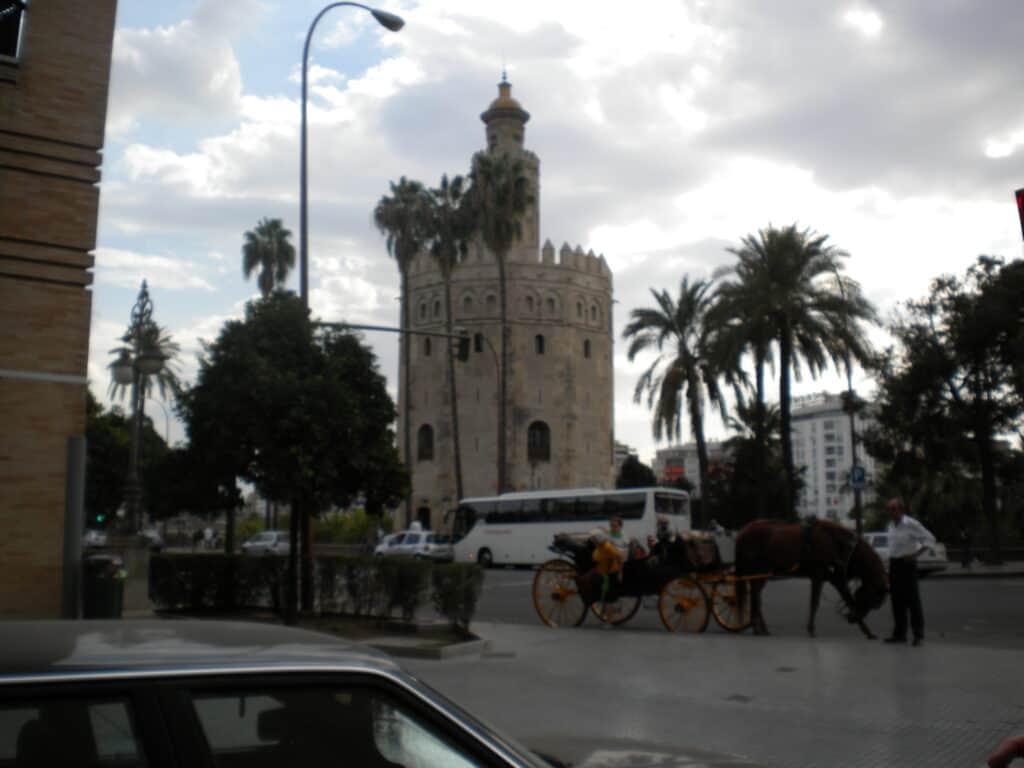
Visit Torre del Oro
The Torre del Oro, or the “Tower of Gold,” was erected by the Almohad Caliphate in the 12th century and served a vital part of the Moorish city wall. This dodecagonal military watchtower served to control access to the city via the Guadalquivir River. The tower stands at a height of 36 metres and served various functions over the years. It has been a watchtower, fortress, prison, and today houses the Naval Museum. The museum spans several floors and contains many maritime exhibits, including flags, maps, scale models of ships, and diving equipment.
In addition to the maritime exhibits, great views of the city can be enjoyed from the tower’s terrace.
Despite its historical significance, the tower is often less crowded than other tourist attractions in Seville, making it a peaceful place to learn about the city’s past and enjoy great views with fewer crowds.
Entrance tickets can be purchased at the entrance and the tower is free to visit on Mondays. Opening times are Mon-Fri 9:30 to 6:45 and Sat-Sun 10:30 to 6:45. The tower is closed on public holidays.
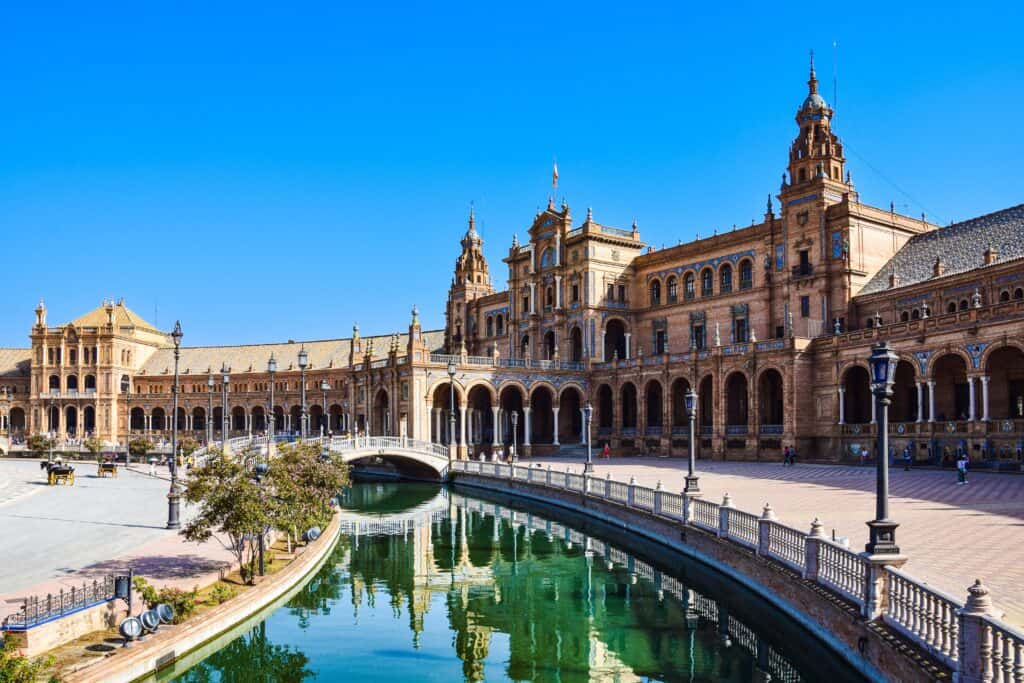
Explore The Plaza de España
The Plaza de España is a beautiful open air half-circle space with buildings running along its edge, accessible over the moat by numerous beautiful bridges representing the four ancient kingdoms of Spain. In the centre, there’s a large fountain, while the walls of the plaza are adorned with colourful ceramic tiles, each representing a different province of Spain.
The Plaza de España was built for the Ibero-American Exhibition in 1929, a world fair aimed at strengthening ties between Spain, its former colonies, and the United States. The man behind its design was Aníbal González, an architect who merged different architectural styles — Renaissance, Moorish, and Art Deco – to create this stunning masterpiece.
The plaza can be explored by foot however another popular way to rent a row boat. As you row around the Plaza, under the bridges, you’ll get a unique perspective on the stunning architecture.
Make sure you visit the the central fountain, a popular meeting spot at the heart of the plaza. The Plaza de España is open to the public 24/7, and there’s no entrance fee. However, it can get crowded during peak tourist season and on weekends, so an early morning or late evening visit might allow you a more peaceful experience.
The surrounding park, the Maria Luisa Park, is also worth exploring for its lush gardens, fountains, and walkways. This public park stretches along the Guadalquivir River and was donated to the city in 1893 by Princess Maria Luisa.
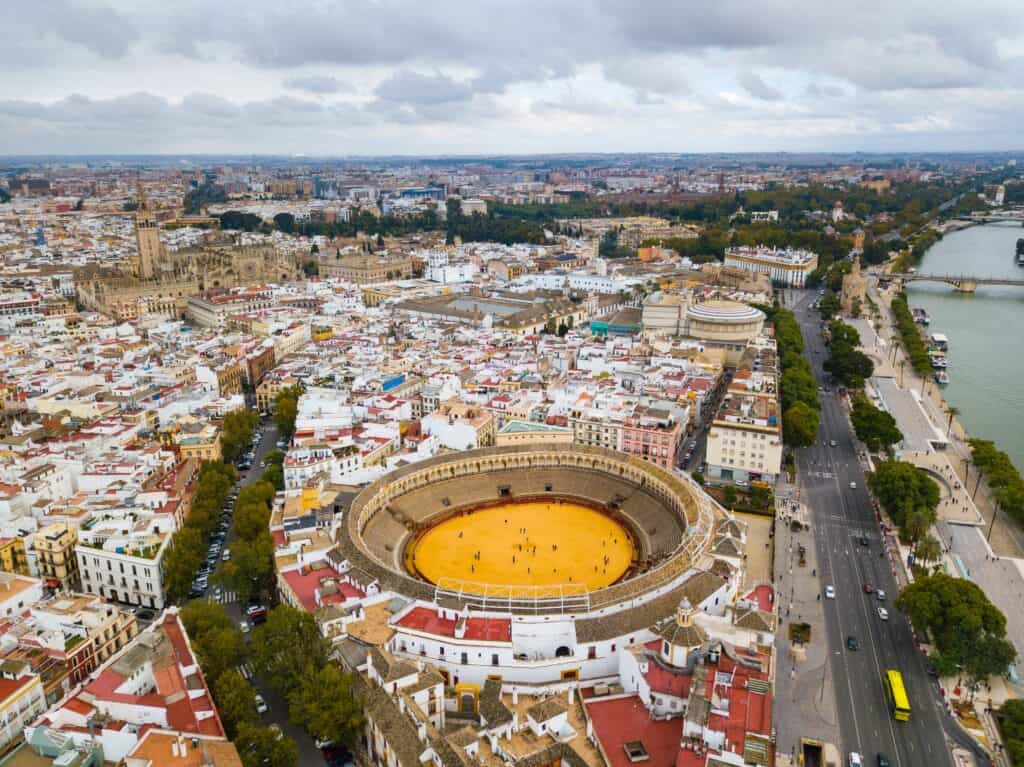
Maestranza Bullring
In the heart of Seville, stands the Plaza de Toros de la Real Maestranza de Caballería de Sevilla, more commonly known as the Maestranza Bullring.
The Maestranza Bullring is one of the oldest and most significant bullrings in Spain. Construction began in 1749, but it wasn’t until 1881 that the arena took its current shape – a perfect circle of elegance and grandeur.
The building is an architectural marvel, with its Baroque façade and yellow and white colour scheme, it stands out amidst the cityscape. The ring itself can accommodate over 12,000 spectators, making it one of the largest and most important in the world of bullfighting.
The Maestranza is not just a bullring; it’s also a museum dedicated to the history of bullfighting. The Bullfighting Museum of the Maestranza offers you an insight into the evolution of bullfighting through its collection of costumes, photographs, and paintings.
Guided tours are available, taking you through the main gate, the chapel where matadors pray before fights, and the infirmary, offering a behind-the-scenes look into this controversial yet deeply ingrained Spanish tradition.
The bullfighting season runs from Easter Sunday through October, with the most prestigious fights taking place during the Feria de Abril (April Fair). But of course it is worth noting that bullfighting is a divisive issue, however a visit to the Maestranza Bullring is worth it for its architectural and cultural significance.
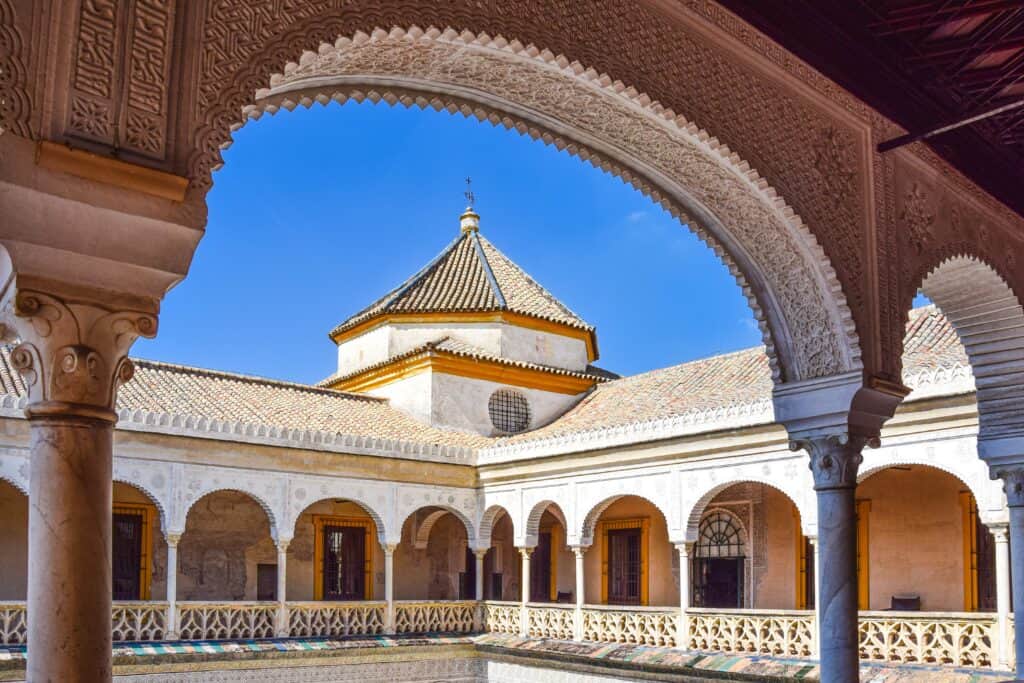
Casa de Pilatos
The Casa de Pilatos, or Pilate’s House, is an Andalusian palace that was built between the 15th and 16th centuries. It serves as the permanent residence of the Dukes of Medinaceli, making it one of the largest private residences in the city.
The Casa de Pilatos is worth visiting due to its unique blend of architectural styles. The entrance is a stunning example of Renaissance architecture, topped with a Gothic roof crest. The main patio is adorned with Mudejar and Plateresque decorations, showcasing the cross-cultural influences that define Andalusian architecture.
Inside, you’ll find rooms named along the theme of the Passion of Christ, including the Hall of the Praetorian and the Chapel of the Flagellation. Another highlight is the Descanso de los Jueces (Judges’ Rest) Room, which further showcases the palace’s intricate architecture.
The gardens also exemplify the Mudejar style, a blend of Renaissance and Moorish architecture. The enchanting gardens feature two galleries accompanied by a central pond and paths edged by hedges. The character of the gardens is closest to that of the architectural surroundings, echoing the aesthetic of the palace itself. The palace is also famous for its magnificent patio and gardens, adorned with coloured azulejos (ceramic tiles) considered to be among the finest.
Casa de Pilatos, is open year-round. It operates from 9-6pm every day during the winter months. From April to October, its summer schedule, it extends its closing time to 7pm. Tickets can be purchased at the entrance and guided tours are also available.
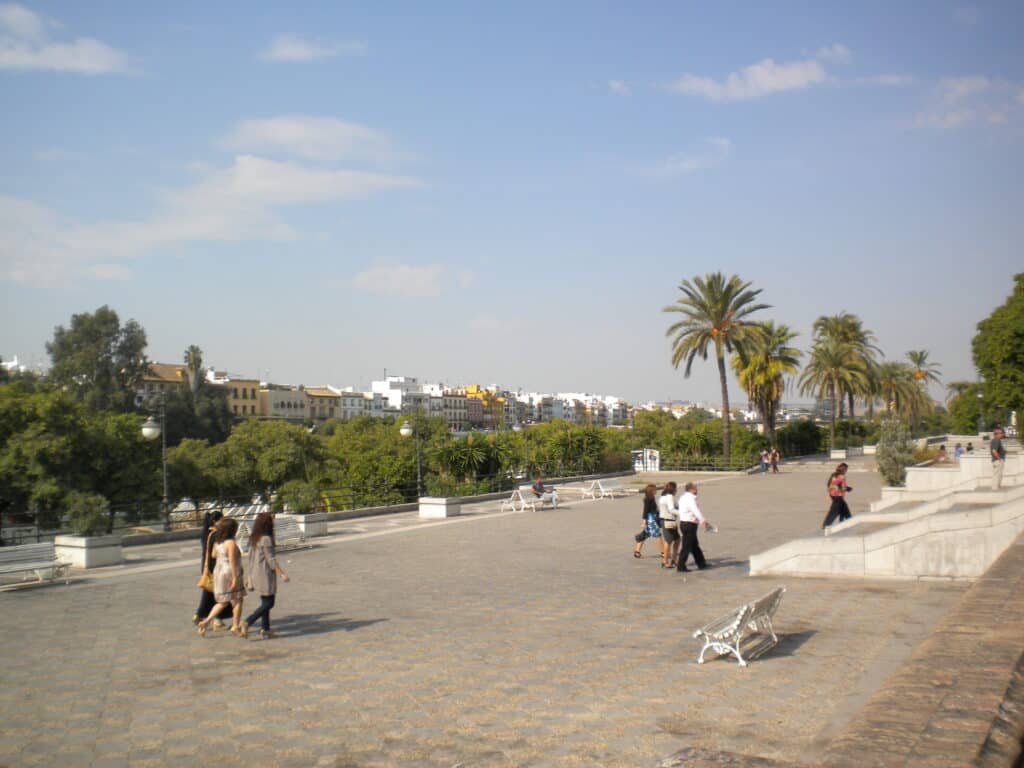
Walk Along The Guadalquivir River Promenade
Walking along the Guadalquivir River promenade is a great thing to do when visiting Seville. This broad promenade on the right bank offers a fantastic view of the city. The walk is perfect for those looking for a leisurely stroll, with a paved walkway that makes it accessible for walkers of all levels.
One of the highlights of this walk is the view of Triana’s awe-inspiring riverfront on the other side of the river. Triana, once the city’s gypsy quarter, is a lively and colourful neighbourhood that sits on the bank of the Guadalquivir River.
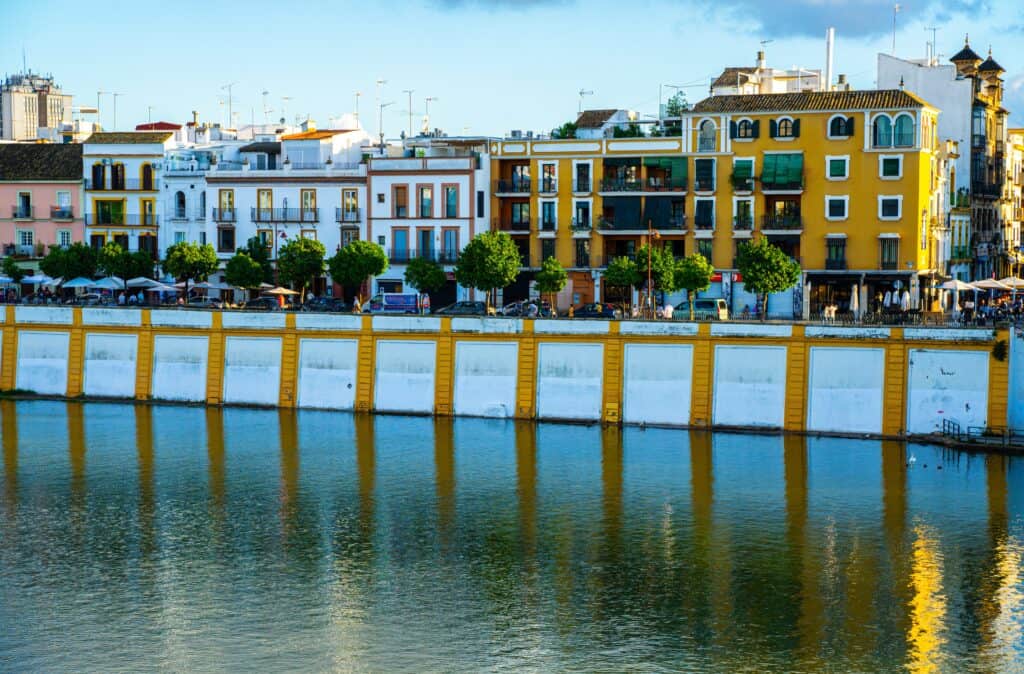
Visit The Vibrant Triana District
On the Guadalquivir River, lies the vibrant and colourful district of Triana. Triana was once Seville’s gypsy quarter and today retains much of its historical charm. As you wander through the narrow, winding streets, you’ll encounter a fascinating mix of old-world charm and modern dynamism. The district is home to several architectural jewels, including the Church of Santa Ana, the oldest in Seville, and the Chapel of El Carmen, both boasting stunning examples of Gothic and Baroque styles.
Triana is celebrated as the birthplace of flamenco, a passionate and evocative art form that combines singing, dancing, and guitar playing. You’ll find numerous bars and tablao venues offering live flamenco shows, where you can immerse yourself in the rhythmic clapping, foot-stomping, and soulful singing that define this captivating Andalusian tradition.
Triana also has a long-standing tradition of ceramic and pottery making. The district’s vibrant, hand-painted ceramics are renowned throughout Spain. Visit the Centro Ceramica Triana, a museum dedicated to this craft, where you can learn about the history of ceramic production and even purchase some beautiful pieces to take home.
Another great thing to do in Seville is to visit the Mercado de Triana. Nestled in the heart of the vibrant neighbourhood and just a stone’s throw away from the Isabel II Bridge. This traditional market is a culinary paradise brimming with local flavours.
Built on the ruins of the Castle of San Jorge, the Mercado de Triana is steeped in history that dates back to the Middle Ages. Today, it stands as a bustling marketplace where you enjoy a taste of Seville’s rich gastronomy.
The market offers a variety of fresh, local produce, including Aljarafe oranges and melons, among other local delicacies. The food stalls are a favourite among locals who can often be found enjoying tapas and drinks.
In addition to its culinary delights, the Mercado de Triana also houses an archaeological site and interpretation centre. Here, you can gain insights into the areas historical significance.
The Mercado de Triana is open six days a week (Mon-Sat) from 9am-3pm. After the stalls have closed there are still many places open for eating and drinking (many of which are open until late). These food and drink places are also open on Sundays, but the market stalls will be closed.
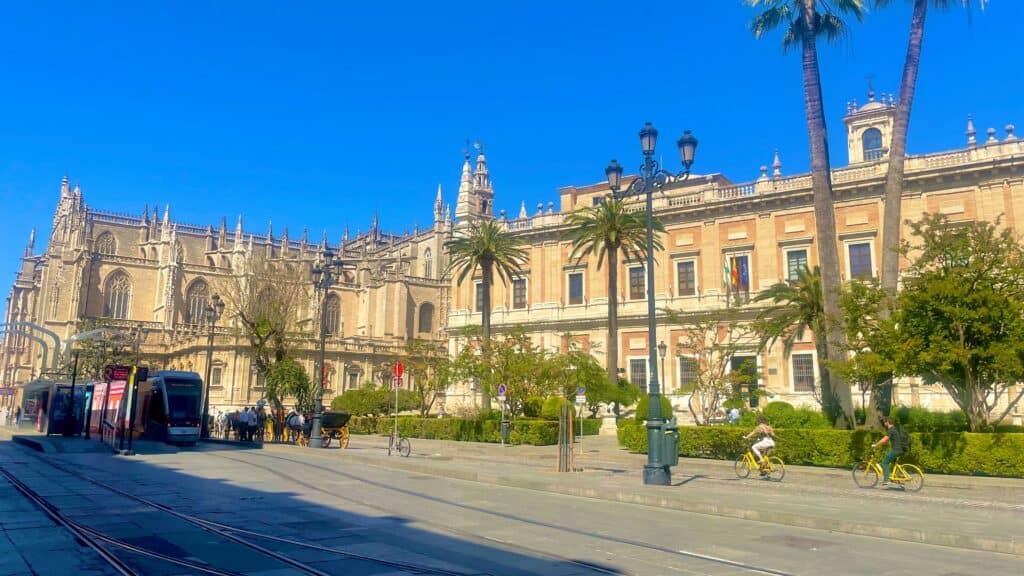
Discover History At The General Archives Of The Indies
Housed in the ancient merchants exchange known as the Casa Lonja de Mercaderes, this archive is a treasure trove of historical records that span centuries.
Built during the reign of Philip II (16th century) and designed by Juan de Herrera, the imposing building itself is a testament to Seville’s rich architectural heritage. Its location on Avenida de la Constitución, adjacent to the cathedral on one side and the Royal Alcázar on the other, places it at the heart of the city’s historical district.
The archive contains more than 10 kilometres of bookshelves filled with documents that tell the story of Spanish colonialism in the Americas. This repository of extremely valuable archival documents dates back to the Spanish Colonial Period, with 80 million pages of documents and maps about the Indies, spanning the 16th, 17th, and 18th centuries.
Visiting the General Archive of the Indies offers a unique opportunity to immerse yourself in the historical narrative of Spain’s powerful past empire. It’s not just a journey through time, but also an exploration of the cultural, political, and social dynamics that shaped the New World.
The archive is open from Tuesday-Saturday 9:30am to 4:30pm. Sunday and holiday opening times are shorter from 10am to 1:30pm. Admission to the archive exhibitions is free.

Visit The Former Royal Tobacco Factory
The University of Seville, housed in the historic Real Fabrica de Tabacos (Royal Tobacco Factory), is a great place to explore.
This 18th century building’s history is as fascinating as its architecture. The Real Fabrica de Tabacos was once the most prominent tobacco factory in Europe, where the world-renowned Sevillian cigars were made. It has also served as the backdrop for Bizet’s famous opera, Carmen, further adding to its cultural significance.
Now the seat of the University of Seville, here you will find courtyards, lecture halls and classrooms. Entrance into the campus area is completely free and is open generally from 8am-9pm. However schedules do vary so it is a good idea to check the university website in advance to get the most current information.
In the same street as the University of Seville (Calle San Fernando) is the historic Hotel Alfonso XIII. This luxury hotel is known for its five star accommodation and high-end dining scene.
Surrounding the University and Hotel Alfonso XIII are charming cobbled streets that are really worth exploring. These streets are lined with traditional tapas bars, quaint shops, and beautiful Sevillian houses adorned with colourful azulejos (ceramic tiles).
Read our blog on Salamanca, if you want to know about the best things to do in Spain’s University city.
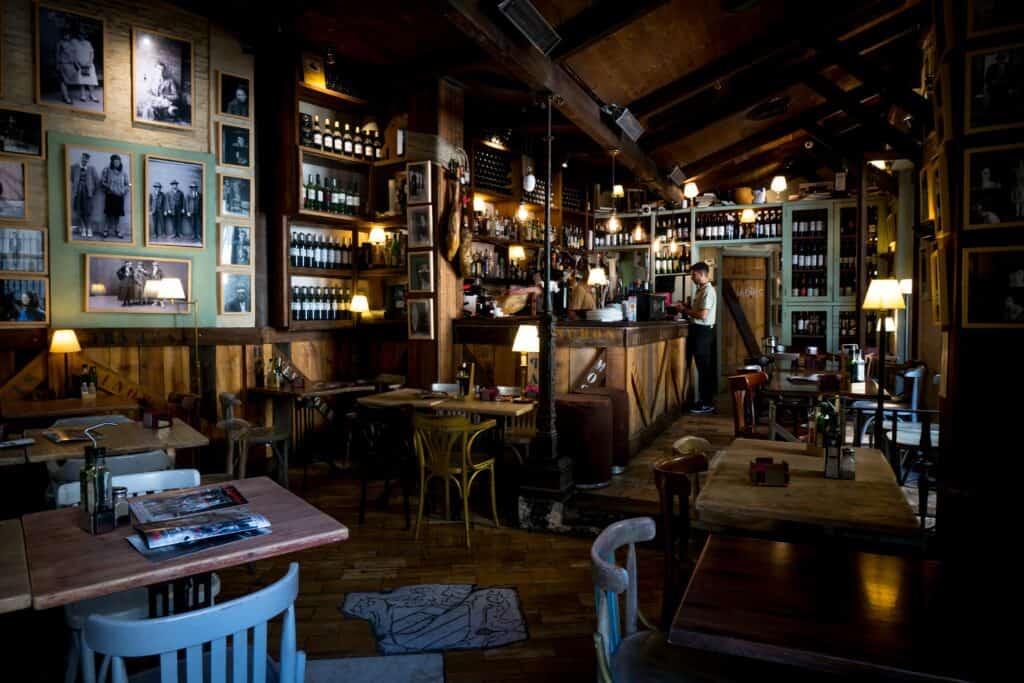
Eat At The Oldest Tapas Bar In The City – El Rinconcillo
Among the numerous tapas bars in Seville, El Rinconcillo holds a special place. Established in 1670, it is recognized as the oldest bar in the city. Stepping into El Rinconcillo is like traveling back in time. The restaurant offers a great selection of tapas, while the décor, complete with wooden beams and antique bottles, adds to the charm. Must-try dishes here include the traditional spinach with chickpeas and cured ham along with avía de bacalao (fried breaded cod) and a superb salmorejo (a puree of tomato and bread.
Visiting El Rinconcillo is not just about enjoying good food and drink; it is about being part of a tradition that has endured for more than 350 years. So make sure you drop by this historic tavern and experience one of the best things to do in Seville.
For more great information on Tapas, read our Tapas – The Ultimate Guide & The Best Tapas Bars In Madrid blog.
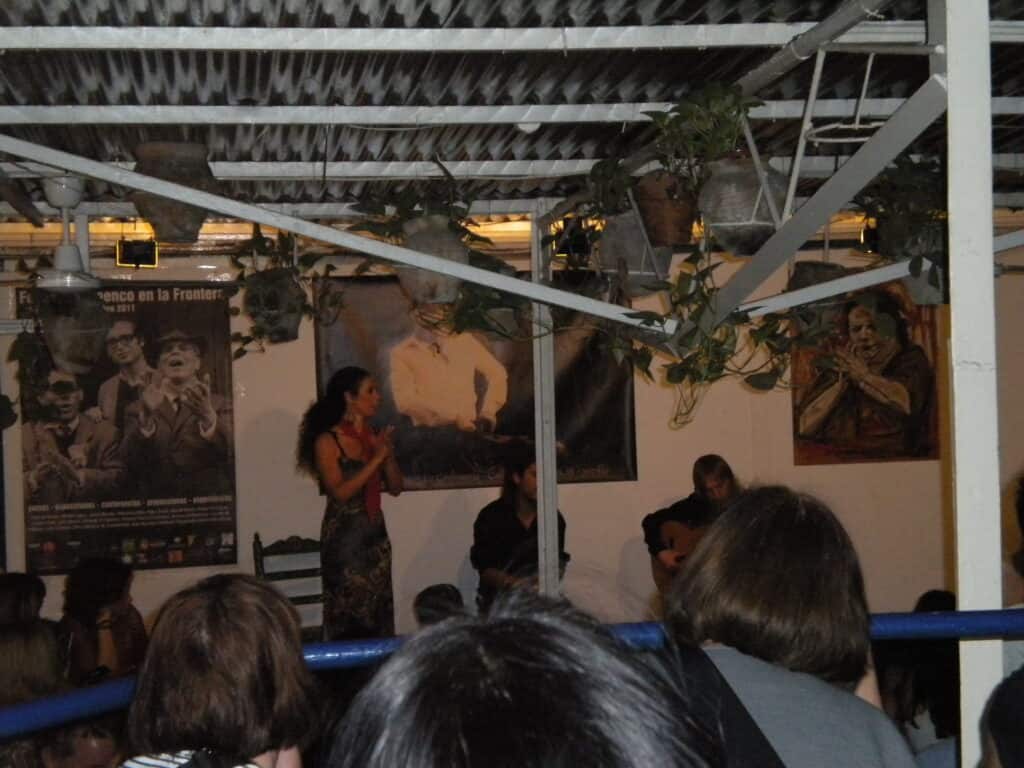
Experience The Passion Of Flamenco
There are many things that make Seville a magical city, but nothing captures its spirit quite like a live Flamenco performance. The birthplace of this passionate art form, Seville offers an authentic Flamenco experience that is not to be missed.
Flamenco is an integral part of Andalusian culture, deeply rooted in the region’s history and traditions. It originated in the 18th century within the Romani communities of Andalusia, and it’s a captivating blend of song (‘cante’), dance (‘baile’), and guitar playing (‘toque’). The heartfelt performances often express themes of love, death, and struggle.
There’s no shortage of places to see Flamenco in Seville, from intimate ‘tablaos’ (Flamenco venues) to larger theatres. Two notable venues are Casa de la Memoria and Tablao El Arenal. Both offer nightly shows and are renowned for their high-quality performances. Do remember to book in advance, as these shows are popular.
Experience A Traditional Arab Bath
One of the unique experiences that Seville offers is the opportunity to visit its traditional Arab baths or ‘Baños’. These are an important part of the the city’s rich Moorish history and provide a tranquil escape from the hustle and bustle of the city.
The tradition of public baths dates back to Roman times, but it was during the Moorish rule in Spain (711-1492 AD) when the culture of ‘hammams’ or public baths truly flourished. These baths were not only places for cleansing but also for socializing and relaxation. Today, modern-day Baños in Seville attempt to recreate this age-old tradition, offering an experience steeped in history and tranquility.
One of the most popular Baños in Seville is the Aire de Sevilla. Nestled in the heart of the Barrio Santa Cruz, entering the Aire de Sevilla is like stepping into another world. The beautifully restored 16th-century building, with its atmospheric lighting and Andalusian architecture, sets the scene for an unforgettable experience.
You start the experience in the warm pool, where you can relax and adjust to the serene surroundings. From there, you move onto the hot pool, where the heat helps to release tension in your muscles. This is followed by a plunge into the cold pool, a shock to the system that is surprisingly refreshing.
The steam room offer further opportunities for relaxation and detoxification. To complete the experience, you may choose to indulge in a massage or a traditional exfoliating treatment.
If you plan to visit the Baños, make sure you book in advance and don’t forget to bring your own swimsuit. Towels are provided.

Visit The Museums
Seville has a number of great museums to visit. Here are some of the museums the city has to offer.
Centro Andaluz de Arte Contemporáneo (Andalusian Museum of Contemporary Art) – Located in a converted monastery, this museum is a hub for contemporary visual arts in Andalusia. The museum hosts temporary exhibitions and has a permanent collection featuring works by international and Spanish artists from the 20th and 21st centuries.
Museo de Bellas Artes (Museum of Fine Arts) – Regarded as one of Spain’s premier art galleries, the Museum of Fine Arts is housed in a stunning 17th-century convent. The museum showcases a remarkable collection of Spanish visual arts from the medieval period through the 20th century, with a special emphasis on works from the Sevillian School of the Baroque period.
Museum Of Illusions – For something a little different, the Museum of Illusions offers a fun-filled interactive experience. This museum is packed with optical illusions and exhibits that challenge perception and create surprising visual effects.
Museo Arqueológico (Archaeological Museum) – Housed in a beautiful Renaissance-style pavilion, the Archaeological Museum features a wide range of artifacts from Prehistoric times to the Middle Ages. Highlights include Roman statues and Moorish ceramics.
Museo de Artes y Costumbres (Museum of Arts and Traditions) – This museum provides an insightful look into the traditional ways of life in Andalusia. Housed in a picturesque Mudejar pavilion, the museum displays a vast collection of items related to popular customs, craftwork, and regional folklore.
The Flamenco Dance Museum (Museo del Baile Flamenco) – This museum is a must-visit for fans of flamenco. It provides a comprehensive overview of the history and evolution of this passionate art form, complete with interactive exhibits and live performances.
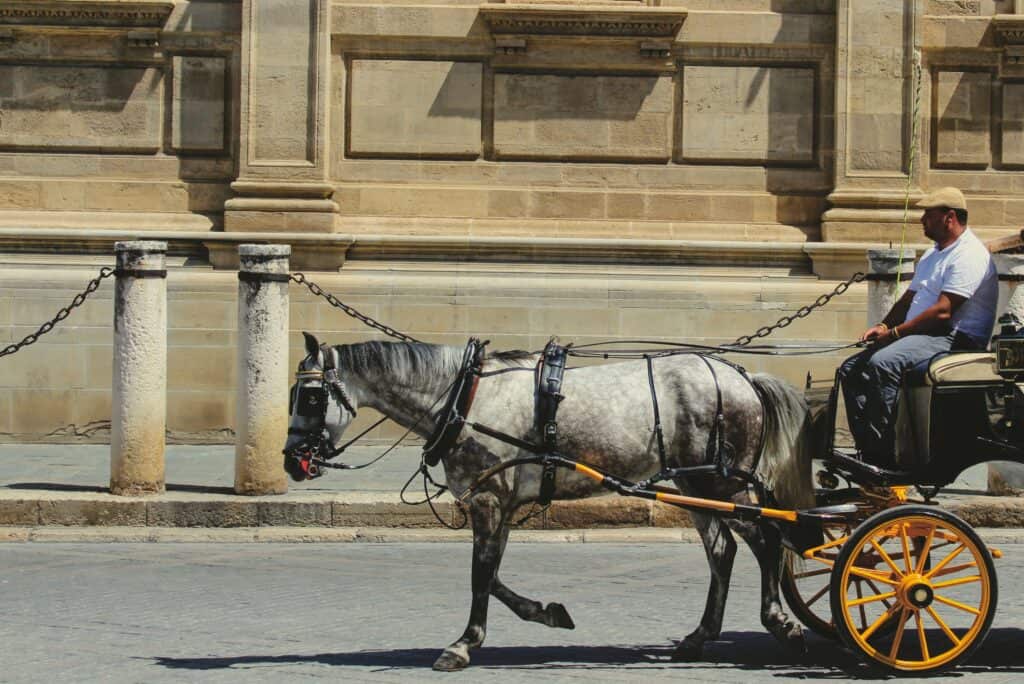
Take A Scenic Carriage Ride
Experiencing Seville from the vantage point of a horse and carriage is one of the best things to do. This timeless mode of transport offers a leisurely way to admire the city sights, allowing you to absorb the sights, sounds, and ambiance at a relaxed pace.
The journey typically begins in the heart of the city, near the stunning Seville Cathedral. As the carriage sets off, you’ll be greeted by the clip-clop sounds of the horse’s hooves echoing off the cobbled streets. This auditory backdrop adds an extra layer of charm to your exploration of Seville’s historic centre.
Your route will likely take you through the city’s districts, including Santa Cruz, with its winding alleys and whitewashed houses, and the Maria Luisa Park, a lush garden filled with exotic plants, beautiful fountains, and colourful peacocks. You’ll also pass by grandiose landmarks such as the Real Alcázar and Plaza de España, where you can marvel at the majestic size and architecture and intricate tile work.
Visit The Church of El Salvador
This church is another baroque masterpiece, with its ornate decor and awe-inspiring altarpiece, is widely regarded as the second most important church in Seville.
The church was constructed on the ruins of an old mosque, echoing the intertwined history of Islamic and Christian cultures in Spain. But its roots go even deeper. Before the mosque, the site was home to a Roman temple, a Palaeochristian, Visigothic, and Mozarab basilica, weaving a complex tapestry of historical influences that can still be felt today.
Built between 1674 and 1712, this baroque church is a marvel of Spanish architecture. Its Mannerist red-brick facade overlooks the Plaza del Salvador, inviting visitors to step into its grand interiors. Inside, stunning stained glass windows bathe the church in a kaleidoscope of colours, while the sacristy, known for its ‘bling’, adds to the opulence.
The Church of El Salvador has varying opening hours depending on the day and time of year. From Monday to Saturday, the church is typically open from 11:00 am to 5:30 pm. However, during the summer months of July and August, the opening hours are slightly adjusted to 10:30 am to 5:00 pm. On Sundays, the church welcomes visitors from 3:00 pm. Again, always check opening times before visiting.
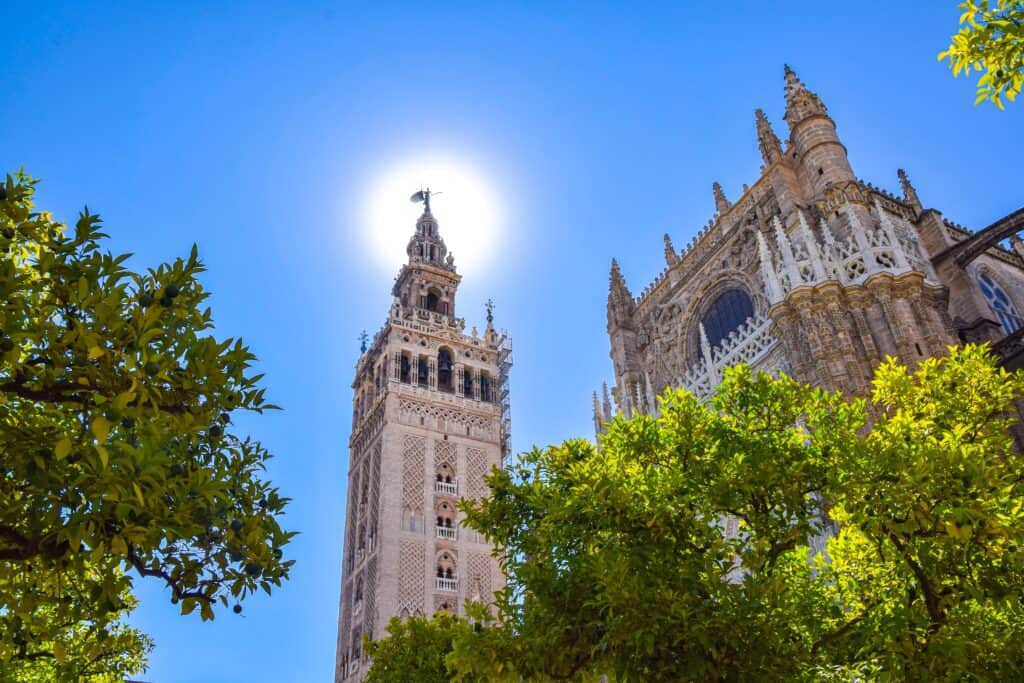
So To Wrap Up On Experiencing Seville…
From the flamenco beats of Triana to the grandeur of Seville Cathedral and the Real Alcázar to the serene Plaza de España, there’s a wealth of great things to see and do in this Andalusian gem.
Further FAQs
How To Get To Seville
There are several ways to reach the city of Seville.
By Air – The most direct way to get to Seville from abroad is by air. The city is served by Seville Airport (SVQ), also known as San Pablo Airport, located about 10 kilometres east of the city centre. The airport offers numerous domestic and international flights, making it easily accessible from many parts of the world. Once you land, you can take a taxi, bus, or rent a car to reach the city centre. The EA bus line provides a direct connection from the airport to the city centre, with buses running every 20-30 minutes.
By Train – If you’re already in Spain or in a neighbouring country, travelling to Seville by train can be a great option. Spain’s high-speed rail network, the AVE, connects Seville with many major cities like Madrid, Barcelona, and Valencia. The journey from Madrid to Seville takes approximately 2.5 hours, making it a quick and convenient way to travel. Seville’s main train station, Santa Justa, is centrally located and well-connected to the city’s public transportation network.
By Car – For those who prefer road trips, driving to Seville can be an enjoyable experience, offering the opportunity to explore the beautiful Spanish countryside along the way. From Madrid, the journey takes about six hours via the A-4 highway. If you’re coming from Malaga (the south) you can take the A-92, which will get you to Seville in about 2.5 hours.
When To Go To Seville
Spring (March – May) – Spring is often heralded as the best time to visit Seville. The city bursts into life with blooming orange trees and exuberant celebrations. March to May is particularly vibrant, with the city hosting two of its most famous festivals. Semana Santa (Holy Week) is a deeply moving religious event, marked by solemn processions. Following closely after is the lively Feria de Abril (April Fair), a week-long celebration filled with flamenco dancing, traditional dress and culture. The weather is warm but not overly hot, perfect for exploring the city’s stunning architecture and outdoor attractions.
Summer (June – August) – Summer in Seville can be quite intense, with temperatures often soaring above 40 degrees Celsius. However, if you’re a fan of the heat, you can enjoy long, balmy evenings and dine alfresco in the city’s many tapas bars. Keep in mind that many locals escape the summer heat, so some smaller businesses may be closed. Despite the heat, the city remains vibrant and energetic.
Autumn/Fall (September – November) – Autumn is another fantastic time to visit Seville. The sweltering summer heat subsides, making way for more comfortable temperatures. September still holds onto the warmth of summer, offering lovely warm evenings. By October and early November, the crowds have thinned out, providing a more relaxed pace for you to explore the city. The weather is still pleasant, ideal for leisurely strolls through the city’s charming streets and parks.
Winter (December – February) – Winter in Seville is mild compared too much of Europe, but these months can see cooler temperatures and occasional rain showers. However, it’s the most affordable season, with appealingly low rates. Despite the cooler weather, Seville in winter has its own charm. The city is beautifully lit up for Christmas, and the Three Kings Parade in early January offers a magical experience for families.
How Much Time To Spend In Seville
Depending on the pace of travel you prefer, at least 3-4 days is recommended to be able to explore and visit all the best things to do in the city.
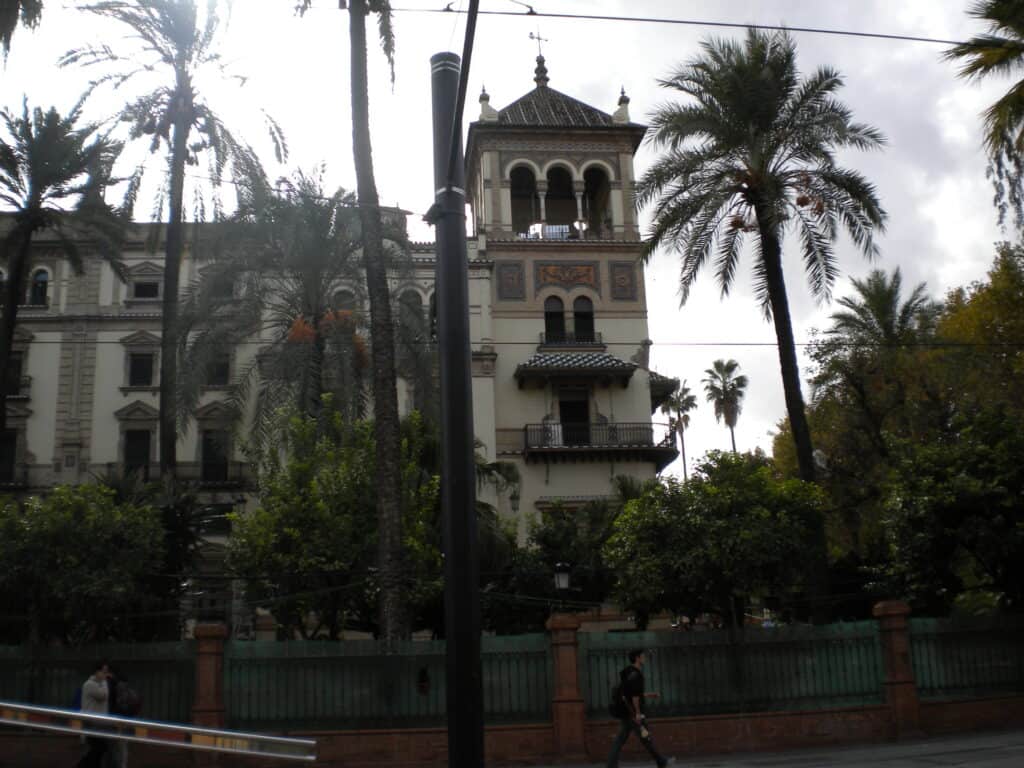
Where To Stay In Seville
Seville has many hotel options, here are some options I recommend.
Disclosure: Please note that the hotel links below are affiliate links. At no extra cost to you, we earn a small commission from each booking that allows us to help maintain this website.
Hotel Alfonso XIII – This is not just a hotel but a symbol of history and tradition. One of the best hotels in Seville, this hotel boasts stunning architecture and opulent interiors. it promises an unforgettable stay.
Hotel Mercer Sevilla – The Mercer offers an upscale experience for guests. Located in the historic centre, combines local heritage with modern comfort, offering a tranquil retreat amidst the city’s hustle and bustle. Amenities also include an outside pool and terrace.
Hotel Boutique Corral del Rey – A great gem tucked away in the heart of Seville. This gorgeous boutique hotel not only offers great rooms but also features a terrific roof terrace with a cooling plunge pool. This boutique hotel is known for its intimate atmosphere and personalised service.
Nobu Hotel Sevilla – Stands out for its stunning views and modern amenities. It’s often recommended for those seeking a luxury experience with a panoramic view of the city’s skyline and roof top pool.
Hotel Boutique Casa de Colón – This hotel offers a unique mix of comfort and style, making it one of the top picks for where to stay in Seville for its great location.
Hotel Unuk – This 5-star establishment located historical centre has emerged as a new icon of luxury and avant-garde in the city. The rooms are sophisticatedly designed with contemporary furniture in muted, soothing tones. A great option.
Plácido y Grata – This 4-star establishment is set in a beautifully preserved 19th-century residence. The hotel’s prime location places you within walking distance of the city’s many attractions, The hotel is praised for its first-class service and well equipped rooms.
Radisson Collection Hotel, Magdalena Plaza – An upscale contemporary hotel located in a leafy plaza in Seville’s central shopping district. The hotel is recognised for its well-maintained rooms and modern, welcoming atmosphere. It offers a range of amenities including a seasonal outdoor swimming pool, fitness centre, terrace, and restaurant.
Hotel Casa 1800 – Is another standout option, offering a mix of classic and contemporary styles. Located in a restored 19th-century mansion, this hotel offers a unique blend of history and modernity.
Hotel Giralda Center – Is an elegant and modern 4-star property known for its friendly staff and excellent facilities. It boasts a seasonal outdoor swimming pool, private parking, a fitness centre, and a terrace with stunning views of the city.
Vincci Molviedro – This modern 4-star hotel is in great location, close to many of the city’s attractions. It offers really comfortable rooms, an outdoor swimming pool, restaurant and terrace area.
For some great tips on booking hotel rooms, read our The Ultimate Guide To Booking Hotel Rooms blog post.
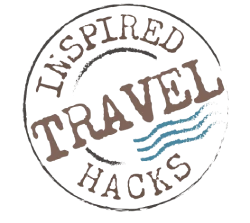

Leave a Reply
You must be logged in to post a comment.